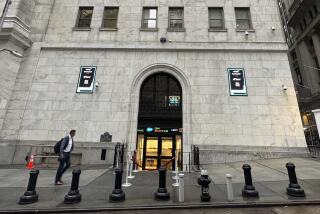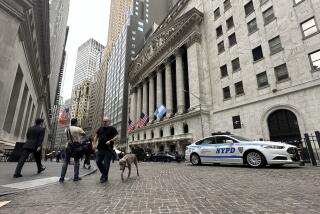Dow Ends Day Above Milestone of 10,000
The stock market’s best-known barometer finished Thursday above the 10,000 mark for the first time in 18 months, putting an exclamation point on a dramatic comeback year for the economy and Wall Street.
The Dow Jones industrial average rose 86.30 points to 10,008.16 in a broad rally that padded what already were hefty gains this year for many investors.
Barring a horrific sell-off in the next few weeks, stocks will post their first positive calendar year since 1999 -- after three years of declines that resulted in the worst investor losses since at least the mid-1970s.
Though there technically is nothing special about round numbers in market indexes, “to revisit 10,000 now is an official signpost that says the worst is over,” said Art Hogan, chief market analyst at brokerage Jefferies & Co. in Boston.
Given the stream of positive economic reports in recent months, the Dow’s climb above 10,000 also adds more credence to the Bush administration’s upbeat assessment of the nation’s prospects heading into the election year, some analysts said.
“For the time being, we have the wind at our backs,” said Charles Crane, strategist at Victory SBSF Capital Management in New York. He noted that short-term interest rates still were at 45-year lows and that tax cuts were helping to pump up consumer and business spending.
In its usual fashion, the stock market earlier this year began to telegraph that the U.S. economy would come roaring back, and with it the corporate earnings that underpin share prices. Indeed, the economy grew in the third quarter at the fastest pace in 20 years, and total corporate earnings in that period reached levels never seen before, government data show.
The market began to soar in March with the onset of the war in Iraq, when the Dow was at 7,524. There have been only a few brief pullbacks since then.
But even as investors count their winnings this year -- the average U.S. stock mutual fund is up more than 27% since Jan. 1, exceeding the blue-chip Dow’s 20% rise -- there is an underlying nervousness about how long the market rebound can continue.
Some veteran investors say the 10,000 level on the Dow could prove to be a long-term ceiling of sorts, in the same way that the 1,000 level was a barrier from 1966 until 1982, after the huge market gains of the 1950s and early ‘60s.
That assessment is heard most often from analysts who believe that low interest rates and tax cuts have provided quick fixes for the economy but haven’t addressed fundamental problems, such as the nation’s massive trade deficit and low savings rates among baby boomers.
“The economic underpinnings are really unhealthy,” said Chip Hanlon, chief domestic strategist at money management firm Euro Pacific Capital in Newport Beach.
Others say that even if the economy continues to grow, stock prices already may reflect the best that can happen in the next few years -- though the Dow and other indexes still are well below the record highs reached in 2000.
The Dow, made up of 30 stocks including General Electric Co., Microsoft Corp. and Wal-Mart Stores Inc., peaked at 11,722.98 on Jan. 14, 2000.
The technology-dominated Nasdaq composite index, which has rebounded 45% this year, remains 62% below its 2000 peak.
Stock prices may still be down from their peaks, but in many cases they are selling at levels that are high relative to company earnings, some analysts warn.
“We think that on any historical comparison the market is terribly overvalued,” Hanlon said.
Yet the pessimists unquestionably are in the minority. More typical is 54-year-old Bill Osmun of Mission Viejo, a commercial leasing specialist and an investor for three decades.
Though he said he worries about the flight of U.S. manufacturing jobs overseas and about the possibility of a major terrorist attack, he has been heartened by booming corporate earnings and productivity, continuing low interest rates and rising business capital spending.
“All that certainly gives me more comfort about being invested in stocks,” Osmun said. He said he was focused on saving for his 17-year-old daughter and 15-year-old son to attend college and to ensure he would be able to retire comfortably.
The faith shown by investors like Osmun this year has largely put to rest worries that much of the public had given up on stocks in disgust, after losing huge sums from 2000 through 2002. The average blue-chip issue fell nearly 50% in that period. Many once-popular technology stocks lost 90% of their value or more.
Mel Miller, a 67-year-old retiree in Upland who has owned stocks for two decades, said he had been giving serious thought at the start of this year to pulling out of the market as his portfolio continued to sag.
“I thought, ‘I need that money to live on,’ ” Miller said. But his financial advisor persuaded him to stay in stocks, advice he now is grateful for, he said.
Miller, who owns stock mutual funds and individual shares, said he hadn’t been deterred by the spreading scandal involving trading abuses by some mutual fund managers and favored clients. None of his funds has been implicated, he said.
But there’s another reason he stays in stocks such as Dell Inc. and Home Depot Inc., Miller said: “There’s no other place to put your money to earn a decent return.”
The Federal Reserve, which again this week pledged to refrain from tightening credit for a “considerable period,” is holding its benchmark short-term interest rate at 1% -- in turn depressing rates on bank savings accounts and bonds that might otherwise compete with stocks.
Some analysts worry that the stock market and the economy have become so addicted to low rates that share prices are sure to suffer the instant the Fed decides to boost rates even slightly.
“One thing that could really pop everything would be if the Fed started raising rates,” said Jack Ablin, chief investment officer at Harris Trust & Savings Bank in Chicago.
The Fed’s current easy-money policy, the record deficit spending of the Bush administration and continued high energy prices also have fueled fears that inflation soon could rise -- as it did in the 1970s, hammering the stock market.
Yet most Wall Street pros say the economy is a much different place than it was in the ‘70s. Global competition will keep inflation down, many say. And U.S. firms, they contend, are far more productive than ever before, which is reflected in rebounding earnings and in investors’ willingness to pay prices for stocks that, relative to earnings, may be above historical averages.
Optimists typically say that though the Dow has struggled after crossing the 10,000 mark in recent years, any comparison with the index’s battle with the 1,000 mark from 1966 to 1982 is misguided.
Joe Keating, chief investment officer at AmSouth Bancorp in Birmingham, Ala., remembers the 1970s as an era when the defining term for American industry was Rust Belt.
“I don’t think anyone would say that today about those parts of the economy where we are competitive,” such as technology and services, he said.
Though he doesn’t see many “screaming bargains” in the stock market after this year’s rally, Keating says he believes that stocks can continue to rise in line with company earnings as the economy grows.
Many investors say they’d be happy with returns far below the 20%-plus per year the market generated in the late 1990s.
For the next few years, “I really predict modest returns -- maybe 6.5% to 7% a year,” Miller said.
Some professional money managers say the surprise could be that the economy, and the market, will perform far better than expected.
“There is a lot of focus on the negative, and not on what may go right,” William Miller, a veteran fund manager at Legg Mason Inc. in Baltimore, said at an investment conference in New York this week. “The bearish view always sounds more reasonable than the optimistic view.”
*
Times staff writer E. Scott Reckard contributed to this report.
More to Read
Inside the business of entertainment
The Wide Shot brings you news, analysis and insights on everything from streaming wars to production — and what it all means for the future.
You may occasionally receive promotional content from the Los Angeles Times.










